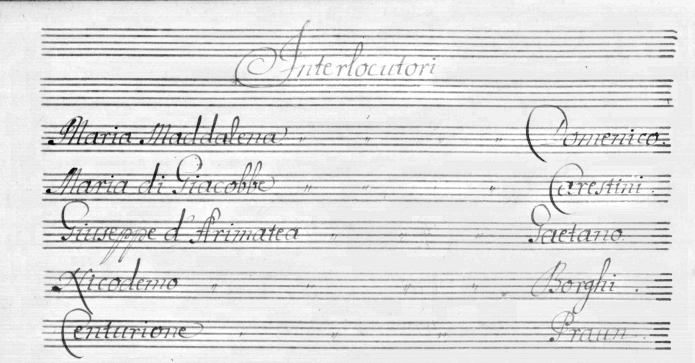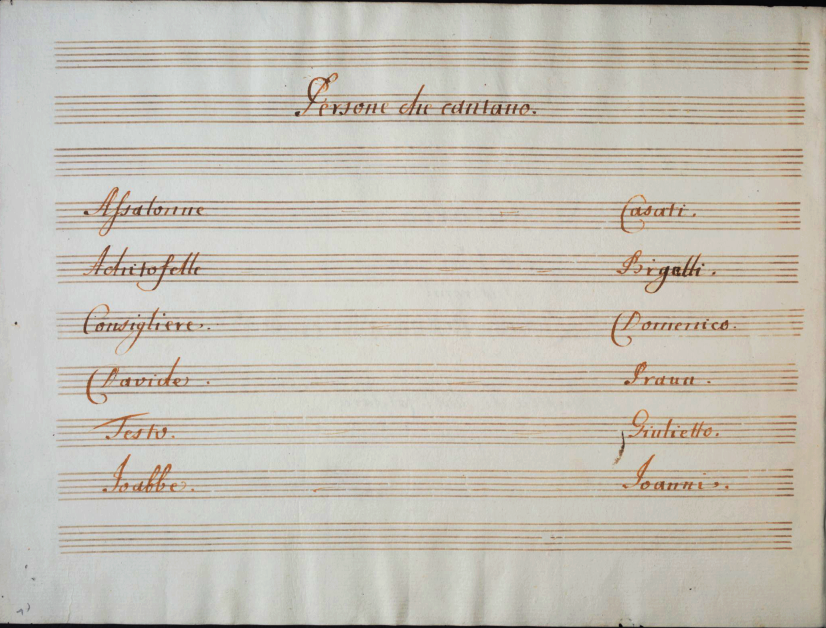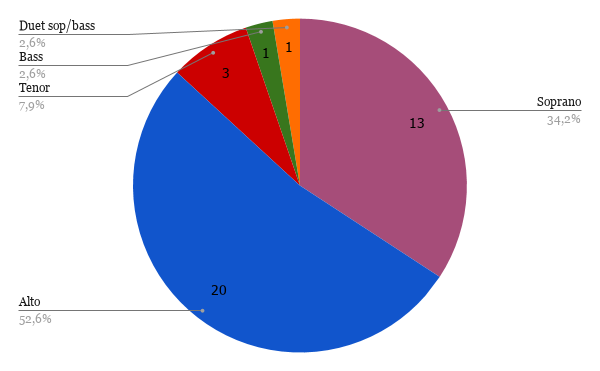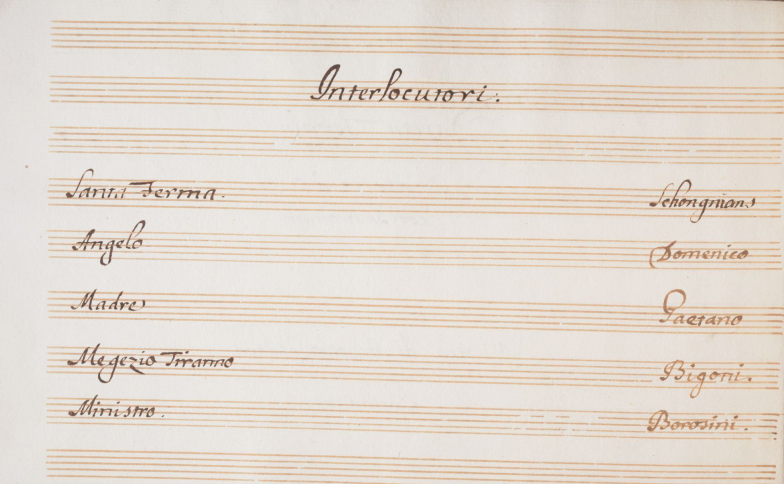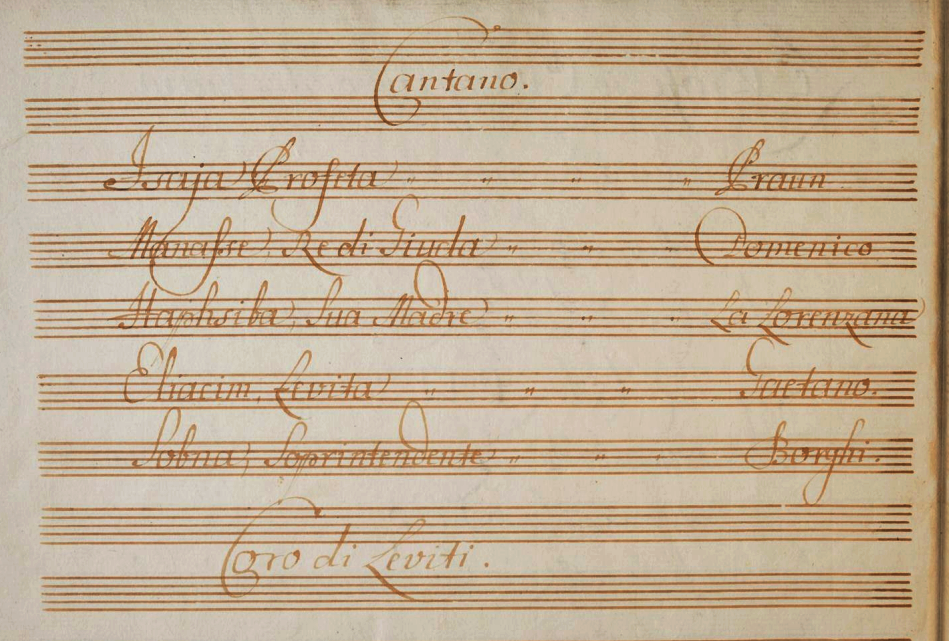Assalone, 1720: A-Wn Mus.Hs.17058
Title role is Assalone, it was created by Casati, a castrato alto. Assalone sings 2 arias with obbligato instruments out of 4.
Morte e sepoltura di Cristo, 1724: A-Wn Mus.Hs.17120
The main role is Maria Maddalena, and it was created by the soprano castrato Domenico. Maria Maddalena sings 3 arias with obb. instruments out of 4 in the oratorio.
In the next section, I will discuss the categories of affect that became obvious to me after reading the texts of the arias. Once the texts were divided into these three categories of affects (pain, warlike feelings and religious feelings) I looked at the instruments associated with them, and it was then that I began to see some recurrence in the attribution of instruments to certain affects.
However, I am aware that I cannot generalise these results to other composers or even to opera. They are simply the results of my research over a specific period of time (1716-1736), in a given geographical area (Vienna Hofmusikkapelle), and a concentration on 24 oratorios by the same composer (Caldara) composed within the spatio-temporal limits defined above.
My aim is not to definitively attribute to each instrument a specific affect, nor to understand why Caldara chose these instruments over others, but to determine the links between the use of these instruments and the affects present in the text. To phrase it in another way, I wanted to identify ways of treating the obbligato instruments according to the atmosphere or the particular emphasis that Caldara wanted to give to a particular affect.
As I mentioned before, I had access to 21 of Caldara's 24 oratorios composed in Vienna between 1716 and 1736. Of these 21 manuscripts, 15 contain arias with obbligato instruments. As you can see in the table above, I had 38 arias with obbligato instruments that I used to answer my research question, which is to understand the link between the affects of the aria and the chosen instrument(s). The maximum of arias with obbligato instruments is four in five of the oratorios, and the minimum is one in four of them.
For which voice type are they mainly written?
On the 38 arias, we can find:
As can be seen in this table, the distribution of arias with obbligato instruments is not necessarily related to the title role of the oratorio. Of the fifteen oratorios with specific instruments, in only half the title role is assigned one or more arias with obbligato instruments. On the other hand, what we can see is the notable recurrence of four singers who sung in most of the 24 oratorios by Caldara composed in Vienna between 1716 and 1736. These were the castrati Domenico (soprano) and Gaetano (alto), the tenor Borosini and the bass Praun (20 oratorios out of 21).
We can see that the tenor and bass roles did not have to sing many arias with obbligato instruments, and in the contrary, Gaetano (alto) and Domenico (soprano) were the ones who sang the most in Caldara's work. The preponderance of important or main roles given to high voices (soprano or alto voices by female singers or castrats) at the time of Caldara was clear. These important roles often carried central texts in the libretti to move the action forward. This might explain the lack of arias with obbligato instruments in the tenor and bass roles in Caldara's oratorios, even if it is not the title roles that perform the majority of these arias with specific instruments, few oratorios give a major role to the bass and tenor voices, which may explain their few arias, especially the few arias with obbligato instruments.
I think that there is not necessarily a link between the singer and the distribution of arias with obbligato instruments. One might think that Caldara distributed these arias to the star singers he had on hand, but this is not necessarily the case. Praun, one of the most virtuoso bass singers of his time, and who sings in almost all of Caldara's oratorios, only sings one aria with 2 bassoons (Gionata). And when the castrato Farinelli, during his stay in Vienna, premiered the title role of Sedecia and also the role of Abel (La morte d'Abel), Caldara did not compose for him an aria with any obbligato instrument either.
However, I noticed that Caldara's vocal writing could change from one oratorio to another, depending on the singers he wrote for. If I take Farinelli as an example, the arias he performs in Sedecia are highly virtuosic, with long coloratura and a very wide range that cannot be found in other oratorios. The same goes for the arias of Bersabea in David umiliato, sung by soprano Holzhauser, which are of a vocal virtuosity that is hardly noticeable in other oratorios. Caldara therefore knew how to adapt to the voices he had at his disposal and how to showcase the best of their abilities.
What I would like to highlight here is the absence of a link between a star virtuoso singer and these arias with obbligato instruments. For me, the use and choice of an obbligato instrument depends more on the character that Caldara wanted to give to the aria than on the emphasis on a voice type or a specific singer. On the contrary, as we will see later, these arias with obbligato instruments are syllabic for most of them, and do not particularly enhance vocal abilities. As if there was something else to be highlighted by the choice of a specific instrument – most likely, the underlying affect.
In this chapter I will present you with a list the 38 arias with obbligato instruments that I found in the 21 Viennese Caldara oratorios to which I had access. In the following table you will therefore see their distribution by oratorios, the name of the character, the instruments, as well as the tonality and tempo. Then I will share with you my thoughts about these arias and their distribution between the different registers of voices. Afterwards, you will see a table of all the singers who sung in Caldara's oratorios. This table gives you an idea of the main place that some of the singers had in Vienna. Finally, I will focus on the different instruments used as obbligato.
As we can see in the graph, more than half of the arias were written for alto voice, followed by soprano, followed by really few arias for tenor, followed by only one aria for bass, and one duet (soprano-bass).
I think we can explain these voice allocations of the arias in several ways:
-
Title role, main character of the oratorios
-
Text of interest for certain instruments in relation to the affect developed (for instance: warrior aria/trumpet)
Several oratorios have a name as title. If we consider that the name carried by the oratorio is that of the title role, then we can see that in the majority of oratorios whose title is a name, the main roles have been given to altos or sopranos (Assalone, Ester, La Santa Ferma for instance). We can also refer to the role allocation page in the manuscripts, because very often the order used to make the list of characters seems to be made so that the main characters are at the top of the list, as can be seen below.
However, there is sometimes no link between the main character of an oratorio and arias with obbligato instruments; not all of the main characters necessarily have arias with obbligato instruments, and sometimes secondary characters sing several of them. In fact, the use of arias with obbligato instruments is, in my opinion, mainly linked to the libretto of the oratorio. It is the text sung by this or that character that will decide whether the composer will use a specific instrument or not, to emphasize a certain affect. We will see this in more detail later.
Thanks to these pages of roles distribution, we know with certainty the singers that were employed at the Hofmusikkapelle. It can therefore help us to understand for whom Caldara composed and if we can see any recurrence among the singers who sung his oratorios. For instance, on these four examples of role distribution, we can already see some names that appear several times: Domenico (4), Praun (3), Gaetano (3), Borghi (2).
Thanks to the 21 oratorios, I was able to get a very precise picture of the singers employed at the Hokmusikkapelle. Some of them participated in 20 oratorios and were given main roles as well as less important roles. Caldara even composed for the world-famous castrato Farinelli in his oratorios Sedecia (1732) and La morte d'Abel (1732).
In the table below, you can see which singers performed which of the roles of the oratorios. "TR" means that this singer had the title role. The orange box means that the performer has sung one (or more) aria with obbligato instrument in this oratorio. The grey columns correspond to the three oratorios that I did not have access to.
Among the 38 arias with obbligato instruments of the Viennese oratorios of Caldara, we can find 2 categories of instruments, divided into 2 sub-categories.
In the previous graph we can therefore observe the number of arias per obbligato instrument in Antonio Caldara's oratorios.
- The instrument most often used as an obbligato is the trombone. It is used three times as a soloist, three times as a trombone duo and three times in association with the bassoon (twice a bassoon/trombone duo, once a duo of two trombones and two bassoons).
While this instrument fell into disuse in most of the major European musical centres at the end of the 17th century, the trombone remained in use in Vienna, where it was even given obbligato parts, as here in Antonio Caldara's oratorios. Its role was once a doubling role, often associated with the cornett,1 but it also played in instrumental ensembles (broken consorts) in the company of stringed instruments. Mersenne and Praetorius considered it quite capable of diminutions and decorations of melodies. According to Trevor Herbert, "from the opening decades of the 16th century until the closing years of the 17th, the trombone was one of the most prominent professional instruments".2 During the 17th century, the trombone was often gathered in groups of trombones used together to produce a homogeneous mass of sound. It is partly because of this use of the trombones in choruses "rather than from the sound of the single instrument, that the symbolic association of trombones with death, the underworld and other dark features of the emotional spectrum derives; while it is difficult to determine the exact point from which such meanings originate, it is certain that these associations were well understood by the start of the 17th century".3
In Vienna, the practice of doubling voices with trombones continued in the 18th century and the trombone became a solo instrument for theatre and church music.
- The second most used instrument (eight times) is the trumpet. The tromba, trumpet, appears three times as a soloist and twice as a duo. The clarino, is used once in a duo of clarini and twice in an ensemble of due trombe e due clarini, that is to say two trumpets and two clarini.
What can be confusing when one reads these two terms is to believe that they are two different instruments. In fact, the tromba and the clarino are the same instrument, but the name chosen corresponds to the register used in the pieces in question. The clarino is the high register of the trumpet. It was apparently common in the Baroque period to name the trumpet by the name of the register used in a piece, as here, the clarino. In the case of our two arias with two clarini and two trombe, it is possible that clarini refers to the first trumpets (with a high register) and trombe to the second trumpets (with a lower register).
The trumpet was most commonly tuned in C or D, in Caldara's arias seven are for C instruments and 1 aria is written for trumpet in D (Onor Divino, in Il Trionfo della Religione).
- The third most common instrument used as an obbligato instrument in Caldara's aria is the chalumeau. It is a single reed instrument, a cousin of the clarinet, which both existed at the same time at the beginning of the 18th century before the clarinet totally eclipsed it. Originally, the chalumeau seems to have been invented so that recorders would produce more sound. The instrument therefore exists in four different sizes: soprano, alto, tenor and bass, which is not the case for the clarinet. It was originally designed as a recorder body combined with a clarinet mouthpiece.
The timbre of the clarinet and the chalumeau are quite different, the latter being considered to be rather soft and compatible with melodies, whereas the clarinet was considered to be louder, less soft and brighter.
The instrument used in Caldara's arias is the soprano chalumeau, written in treble clef. It enjoyed great popularity at the court of the Habsburgs,4 and Joseph I even composed an aria for this instrument in an opera by Marc'Antonio Ziani (Chilonida, 1709).
It is possible that the arias Antonio Caldara composed were played by Andreas Wittmann (or Widmann, or Widtmann), oboist and chalumeau player at the Habsburg court, considered a virtuoso by Johann Joseph Fux: "the most outstanding virtuoso I have ever heard, on the oboe and also the chalumeau".5
According to Sandra Perez Romero, "Vienna was the Chalumeau capital during the 18th century with the majority of its repertoire written and performed in the Hofkapelle".6
After having spoken about these three instruments, which alone account for three quarters of the arias with obbligato instruments, we are left with fourteen arias divided between the five remaining instruments. With four arias each, we find first the cello, the salterio and the bassoon.
- The cello is used three times as a solo instrument and once as a cello duo. I was surprised not to see this instrument more often as an obbligato as Antonio Caldara was a cellist.
- The psalterium (or salterio as written in the manuscripts) is an instrument consisting of a trapezoidally shaped (mostly) wooden resonance box on which metal strings are stretched. The instrument is played horizontally on a raised support, placed directly on the musician's lap or, in the case of popular music, attached by straps to the musician's shoulders and resting against his or her belly. It is an instrument with struck or plucked strings (depending on the way it is played), and it is sometimes associated with the strings or just accompanied by a basso continuo in the oratorios of Antonio Caldara. This instrument is called psalterium or cymbalom when played with a plectrum or small tabs, but it is called pantaleon or tympanum when played with small leather-covered hammers.7 The mention of salterio in Antonio Caldara's manuscripts leads me to believe that it was rather the first version with plucked metal strings. But as the inventor of a modern version of this instrument, Pantaleon Hebenreit, was very popular throughout Europe at the beginning of the 18th century, it may also be the generic name given to this instrument by Antonio Caldara in the manuscripts, and may in fact refer to the version with strings struck by small hammers.
What allows me to put forward the idea that it would be the hammered version that prevailed in Vienna is that the "cimbalist" of the Hofkapelle was Maximilian Joseph Hellman and that he was sent by Charles VI to train with Pantaleon Hebenreit between 1719 and 1723 in Dresden, before being officially employed at the Vienna Hofmusikapelle from 1724.8 This would also explain why arias with salterio do not appear in Caldara's oratorios until 1725 with Le Profezie evangeliche di Isaia.
- The bassoon is used three times in combination with the trombone and once as a bassoon duo in the only bass aria with obbligato instrument in Antonio Caldara's oratorios. According to Wouter Verschuren, professor at the Royal Conservatoire of The Hague, the combination of trombone and bassoon is quite old and dates back to the 17th century. The dulcian, cornet and trombone were then often used to double voices in polyphonic vocal passages. The continuation of the tradition of voice doubling in Austria and especially in Vienna at the end of the 17th and beginning of the 18th century is particularly visible in the music of Johann Joseph Fux. Indeed, his Missa Sti. Joannis Nepomucensis (composed around 1720) contains parts for bassoon, cornet and two trombones "colla parte". He also composed, in another genre, a sonata a Quattro for violin, cornet, bassoon, trombone and organ. It may be assumed, therefore, that this kind of sonority was quite common in Vienna, and that Caldara was inspired and imbued with it from those early years there. The first appearance of this trombone/bassoon combination appears in 1724 in Morte e sepoltura di Cristo.
Using the trombone and bassoon in choral writing for lament arias in two oratorios, Antonio Caldara nevertheless knew how to write virtuosically for the bassoonists he had on hand. Achia's bass aria (in Gionata, 1728) and Jojada's viola aria (in Gioaz, Re di Giuda, 1726) show virtuoso writing, all in sixteenth notes and arpeggios. Arias for bassoon obbligato seemed almost common and at any rate popular in the 18th century Vienna, both in opera and oratorios, as shown in a compilation of twelve arias for bassoon obbligato, more than 200 years old, which can be found in the Österreischiche Nationalbibliothek.9
- The next instrument is the violin, with three arias. I did not consider the pieces with strings to be arias with obbligato instruments. I concentrated on arias in which solo or concertante was mentioned in connection with one or two violins accompanied by basso continuo and other strings such as concerto grosso or ripieni. That's why we find so few of them, even though 90% of the arias in Caldara's oratorios are actually written for strings (violini I and II, viole) and basso continuo.
- The ultimate instrument used is the viola da gamba, which appears twice as a solo instrument only accompanied by basso continuo. The rather rare use of the viola da gamba in Antonio Caldara's oratorios could be linked to its later use in the 17th century in Vienna, particularly in the sepolcri.10 The instrument was then prized for lament arias, which is however not the case in the two arias from Caldara's oratorios.
My curiosity about Antonio Caldara's arias with obbligato instruments is partly due to the fact that I had rarely heard them as obbligato. I was not used to seeing an almost common use of these instruments in the pieces I know and have sung before. Now that I have studied this geographical and temporal era in more depth, I think their use was actually much more common, but until now, having remained limited to certain standard composers of the 18th century Baroque period, I had had very little knowledge of pieces with these instruments. This explains my interest in these particular arias, and the desire to try to understand the links between the choice of these instruments and the affects that are reflected in the texts and the music.
La Santa Ferma, 1717 (2d version): A-Wn Mus.Hs.17089
The title role is Santa Ferma, it was created by the soprano Regina Schongnians. Santa Ferma sings 2 arias with obb. instruments out of 3.
Le profezie evangeliche di Isaia, 1725: A-Wn Mus.Hs.17122
Rare in Caldara's oratorios are the main role for bass as here (Praun). We can see in the table above that the 2 arias with obbligato instruments of this oratorio are for Eliacim, a secondary character who sings only these two arias and one duet.
Back to table of contents
To next chapter: Obbligato instruments and affects
